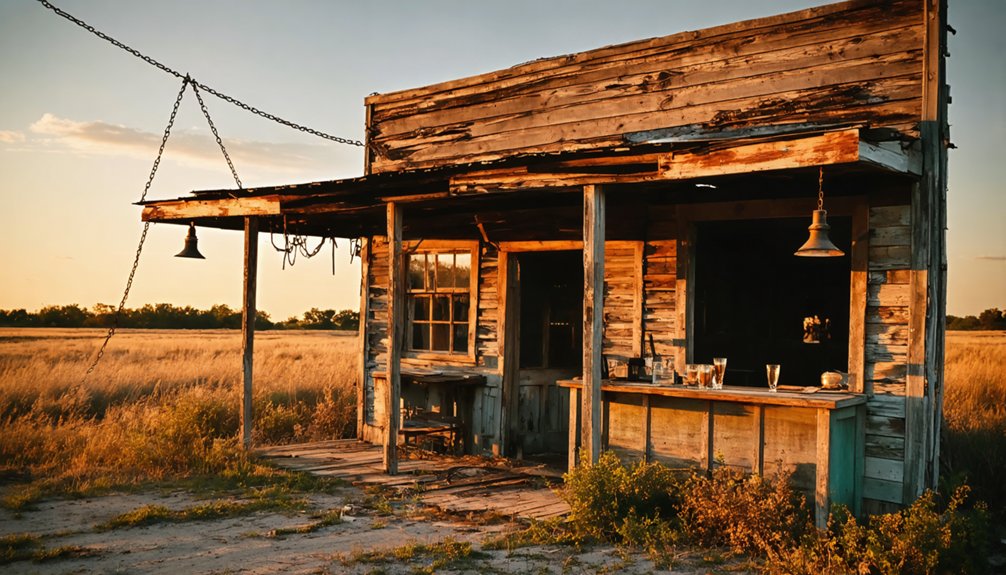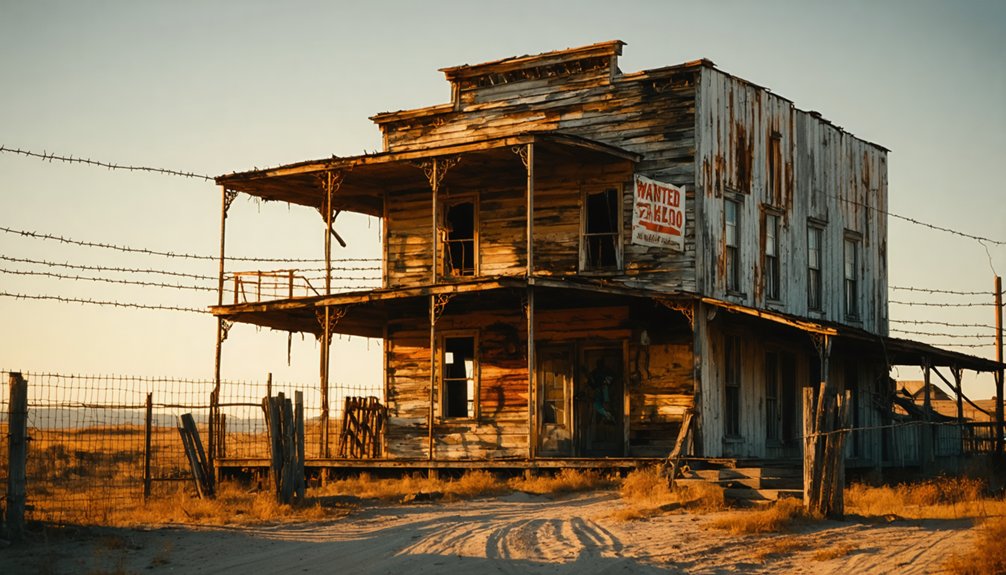You’ll find over 300 ghost towns scattered across North Dakota’s plains, silent remnants of the 1871 railroad boom. These abandoned communities—from Sims with its preserved Lutheran church to Wheelock’s deteriorating schoolhouse—tell stories of immigrant dreams and rural collapse. Economic hardship, the Dust Bowl, and agricultural mechanization triggered mass exodus by the 1930s, leaving architectural skeletons behind. Each crumbling structure holds chapters of American history waiting to be uncovered.
Key Takeaways
- North Dakota’s ghost towns emerged after the 1871-1889 railroad boom that established over 2,000 miles of track.
- The Great Depression and Dust Bowl droughts of the 1930s triggered mass exodus from once-thriving communities.
- Abandoned structures like Wheelock’s schoolhouse and Sims Lutheran Church remain as physical remnants of vanished towns.
- These ghost towns preserve diverse immigrant narratives from German, Ukrainian, Irish, Dutch, and Jewish settlers.
- Extensive photographic documentation since 2003 has captured over 65,000 miles of North Dakota’s abandoned settlements.
The Railroad Boom: Birth of Prairie Communities
Steel rails stretching across the vast Dakota Territory in 1871 marked the beginning of an unprecedented transformation of North Dakota’s landscape and demographic composition.
As you explore these ghost towns today, you’re walking through the remnants of a strategic railroad expansion that once brought life to the prairie.
Between 1871 and 1889, an impressive 2093 miles of track were laid throughout the territory, creating a network that would forever change the region’s development.
Economic Collapse and Environmental Challenges
While railroad expansion initially brought prosperity to North Dakota’s rural communities, the tide of fortune dramatically shifted as the 1920s gave way to the crushing economic collapse of the Great Depression.
You’d have witnessed agricultural adversity in its most severe form—falling crop prices following World War I devastated family farms, while the 1930s Dust Bowl delivered catastrophic droughts that rendered fields unproductive.
Local banks shuttered, eliminating critical access to credit. Economic decline accelerated as mechanization transformed farming, requiring fewer workers and enabling farm consolidation.
The financial backbone of rural communities collapsed as machines replaced men and land passed from many hands to few.
The towns you might’ve called home withered as transportation infrastructure evolved—new highways bypassed these communities while over 100 miles of railroad lines were abandoned by 1930.
These combined forces drove mass exodus as residents sought opportunity elsewhere, leaving only remnants of once-thriving prairie towns. Arena exemplifies this pattern with its population plummeting to just 35 residents by 1935. The smallest county seat of Amidon represents this decline, nearly becoming a ghost town itself despite its administrative significance.
Exploring the Remnants: What Stands Today
What haunting tributes to prairie ambition remain across North Dakota’s abandoned landscapes? You’ll find Sims Scandinavian Lutheran Church—remarkably preserved with its distinctive church architecture—still conducting services despite the surrounding emptiness.
It harbors the famous “Gray Lady Ghost” legend, where ethereal organ music reportedly fills its silent halls.
Burnstad offers contrasting metallic modernity with its hardware store and retail building, anchored by a symbolic town pump.
Gascoyne’s commercial structures stand defiant against time, while Wheelock’s deteriorating schoolhouse signals nature’s reclamation.
Arena, located approximately 35 miles northeast of Bismarck, shows limited structural remains of its once-thriving community founded in 1906.
Sherbrooke, once impressive enough to host President McKinley in its hotel during 1896, has since fallen from its status as county seat to near obscurity.
Railroad remnants trace the economic arteries that once sustained these communities—BNSF tracks still bisect Wheelock, while Charbonneau’s grain elevators mark ghost corridors where trains no longer pass.
Many sites retain nothing but cemeteries—final monuments to communities that flourished, then vanished into prairie winds.
Cultural Heritage and Immigrant Stories
North Dakota’s ghost towns whisper cultural narratives far more complex than their abandoned structures might suggest.
When you explore Arena, you’re walking through streets once bustling with German immigrants and Jewish merchants who pioneered experimental farming techniques.
In Kief, Ukrainian immigrant narratives reveal generations fleeing religious persecution, their descendants still preserving these stories today.
Irish roots run deep in Bantry, named after County Cork, while Hull and Westfield showcase Dutch settlement patterns through architectural remnants.
Even Griffin’s modest history encompasses diverse homesteader origins, from Chinese railroad workers to “One-Eyed Bill” Atkinson.
Griffin’s forgotten landscapes hold surprising diversity—Chinese laborers, eccentrics like “One-Eyed Bill,” all woven into prairie history.
These abandoned communities represent microcosms of cultural preservation—where Ukrainian traditions, Irish farming practices, and Dutch customs once flourished alongside innovative agricultural experiments.
Kiev tells a similar story of cultural perseverance, founded by Ukrainian settlers who sought refuge from religious persecution in the promising North Dakota prairies.
Each ghost town embodies America’s immigrant experience, captured in the prairie’s windswept silence.
These historical locations offer unique experiences for visitors seeking to connect with North Dakota’s rich cultural heritage.
Documenting the Lost: Photography and Historical Preservation
Since 2003, the systematic photographic documentation of North Dakota’s ghost towns has transformed from a casual hobby into an essential historical preservation initiative.
You’ll find these visual archives spanning over 65,000 miles traveled across every county, capturing abandoned towns before time claims them completely.
Photographers employ specialized photographic techniques to document diverse structures—churches, schools, military installations—while maneuvering overgrowth and degradation.
Their work incorporates historical context through research into homesteading laws and railroad expansion, creating meaningful narratives beyond mere images. The importance of this work becomes especially apparent when considering structures like Gingras Trading Post, North Dakota’s oldest building still standing on its original foundation.
These photographs now serve as preservation surrogates for vanishing sites, entering the public domain through digital platforms like Ghosts of North Dakota. This work has culminated in several publications, including the recently released coffee table book featuring churches from across the High Plains region.
This democratization of access allows you to virtually explore these abandoned places, connecting with North Dakota’s heritage despite the physical structures’ inevitable decline.
Frequently Asked Questions
Are Ghost Towns Legally Accessible to Visitors?
Some ghost towns are legally accessible via public lands, while others require permission due to private ownership. You’ll need to navigate legal restrictions carefully, prioritizing visitor safety and property rights.
Do Any Ghost Towns Have Reported Paranormal Activity?
Yes, Sims reports a “Gray Lady Ghost” playing the organ. You’ll discover several haunted locations across North Dakota where paranormal investigations document apparitions, unexplained noises, and moving objects in these abandoned sites.
How Quickly Did the Average Ghost Town Decline?
Half of a town’s residents often fled within a decade. You’d witness rapid population decline driven by economic factors—agricultural depression, bank closures, and mechanization—that transformed bustling communities into emptiness within 10-20 years.
Which Ghost Town Is Considered Most Historically Significant?
Fort Buford is most historically significant, with its preserved historical landmarks and military heritage. You’ll appreciate how it witnessed notable residents including soldiers who shaped America’s frontier during the uncertain Dakota Territory period.
Can Metal Detecting Be Done at Abandoned Town Sites?
You can do metal detecting at abandoned town sites, but you’ll need proper permissions from private landowners or authorities. These locations may yield historical artifacts, though legal restrictions protect sensitive archaeological areas.
References
- https://www.youtube.com/watch?v=-E2DA6Ryd1g
- https://www.ndstudies.gov/sites/default/files/LessonPlans/LessonPlan-HighSchool-GhostTownsOfNorthDakota.pdf
- https://www.legendsofamerica.com/crystal-city-north-dakota/
- https://core.ac.uk/download/pdf/345016075.pdf
- https://ghostsofnorthdakota892857007.wordpress.com/2015/10/30/true-ghost-towns-population-zero/
- https://www.youtube.com/watch?v=0n3LvrSDRLU
- https://www.onlyinyourstate.com/experiences/north-dakota/ghost-towns-nd
- https://www.youtube.com/watch?v=MZ_xZ0d_TBY
- https://northernsentry.com/2025/06/26/north-dakota-ghost-towns/
- https://ghostsofnorthdakota.com/tag/abandoned/



